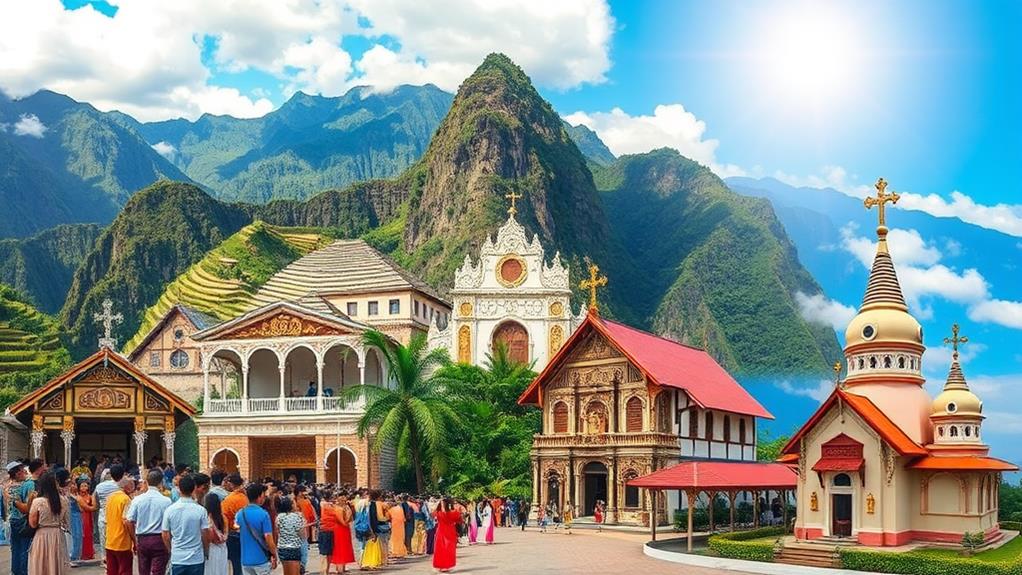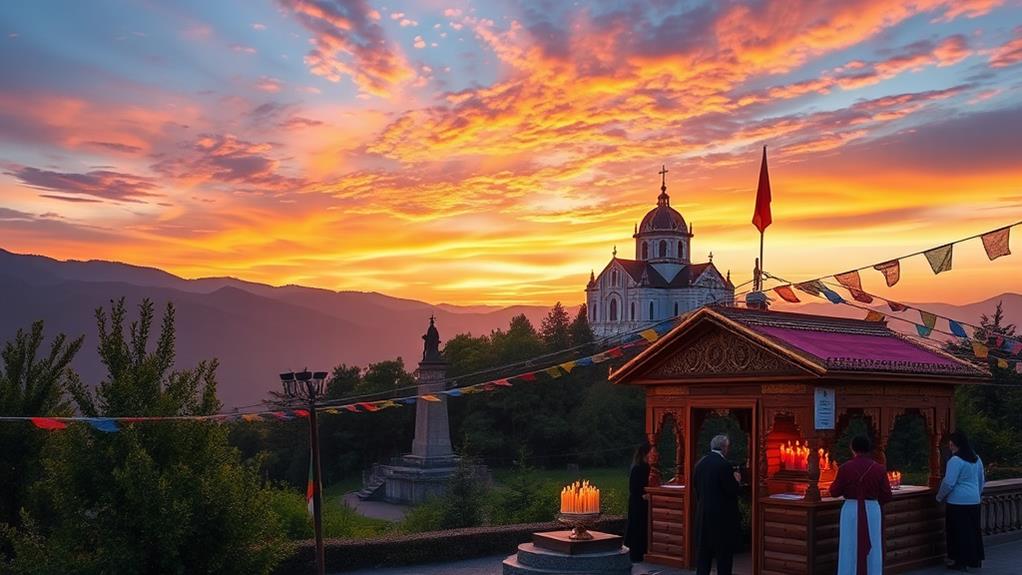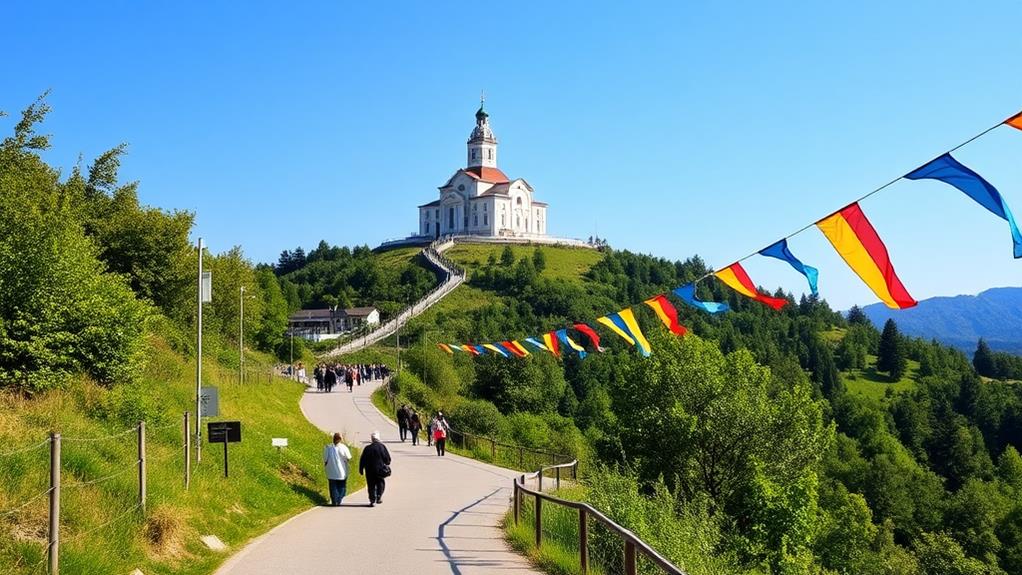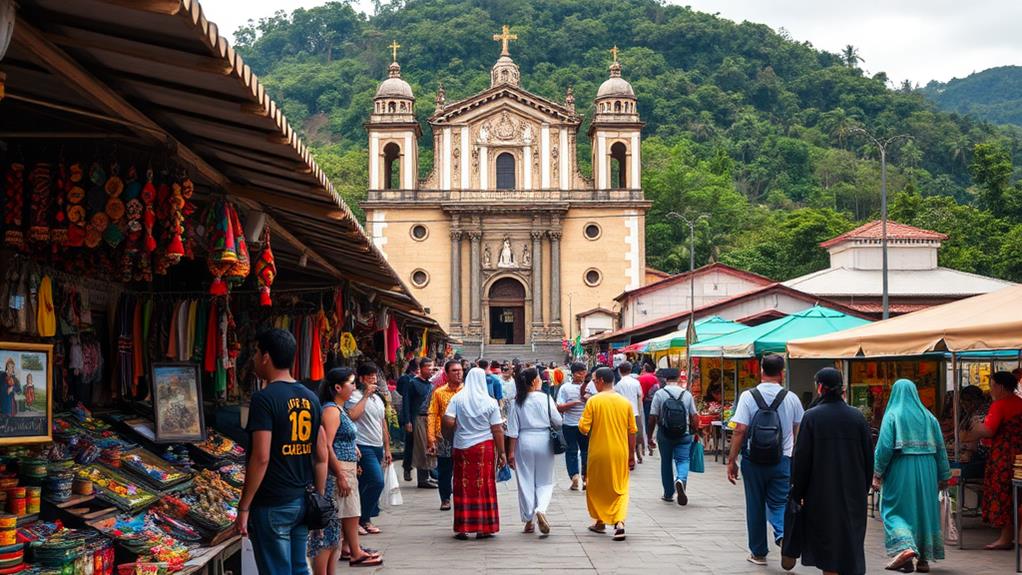Religious tourism in the Philippines is a journey through sacred sites steeped in culture and spirituality.
The country is home to numerous historic sites, such as the stunning Paoay Church, a UNESCO World Heritage Site, and Magellan's Cross, a symbol of the country's Christian heritage.
One of the most significant religious events in the Philippines is the Traslaciμcn of the Black Nazarene, which attracts millions of devotees every year.
Nature plays a vital role in enhancing spiritual journeys in the Philippines, particularly at Mount Banahaw, a sacred mountain considered the "Holy Mountain of the Philippines."
Engaging with local communities is also essential to a meaningful spiritual experience, as it allows for authentic cultural interactions and a deeper understanding of the country's rich heritage.
Discovering the significance of these sacred sites provides a deeper understanding of the country's history and culture.
By exploring these treasures, visitors can gain a more profound appreciation for the Philippines' rich spiritual heritage.
Overview of Religious Tourism

Religious Tourism in the Philippines
The Philippines, a predominantly Catholic nation, attracts both local and international visitors who come to explore its sacred sites and unique religious practices.
The country is home to over 128 churches in Metro Manila alone, many of which are designated as cultural treasures. These churches showcase a stunning blend of modern and historical architecture, reflecting the country's rich cultural heritage.
Notable Pilgrimage Sites
The Basilica del Santo Niño in Cebu and Paoay Church are two of the country's most significant pilgrimage sites.
These sites draw millions of pilgrims each year due to their historical significance and breathtaking beauty. The Traslación of the Black Nazarene in Quiapo is another notable event, one of the largest religious gatherings in the world, which highlights the profound devotion of the Filipino people.
Supporting Local Communities
Engaging in religious tourism in the Philippines not only provides a spiritual journey but also supports local communities.
Increased visitor spending helps sustain these sacred sites while fostering cultural preservation. Whether seeking a deeper connection to one's faith or simply wanting to experience the vibrant religious culture, the Philippines offers a captivating experience that resonates deeply with every traveler.
Notable Sacred Sites
The Philippines is home to numerous sacred sites that captivate visitors with their rich history and spiritual significance.
Mount Banahaw is a popular pilgrimage site, revered for its miraculous healing powers and lush biodiversity. This mountain is a sacred space where visitors seek spiritual enlightenment and physical healing.
Cagsawa Ruins, located near Mayon Volcano, serves as a poignant historical site, reminding us of nature's destructive power. The ruins stand as a testament to the devastating eruption of Mayon Volcano in 1814, which buried the town of Cagsawa under volcanic debris.
Magellan's Cross, situated in Cebu City, is a significant holy site symbolizing the arrival of Christianity in the Philippines. This cross marks the spot where Spanish conquistador Ferdinand Magellan first planted the cross in 1521, introducing Christianity to the Filipino people.
Christ of the Divine Mercy, a towering 50-foot statue in Cagayan de Oro, invites visitors to explore its interior and appreciate its message of faith and devotion. This iconic statue serves as a beacon of hope and spirituality, drawing pilgrims from across the country.
Paoay Church, a UNESCO World Heritage site, is celebrated for its stunning Baroque architecture, designed to withstand earthquakes. This historic church, built in the 17th century, showcases the country's rich cultural heritage and its ability to adapt to natural disasters.
These sacred sites not only serve as pilgrimage destinations but also offer a glimpse into the Philippines' rich cultural tapestry. They provide a unique opportunity for visitors to explore the country's spiritual traditions and cultural heritage, making for an unforgettable experience.
Unique Spiritual Experiences

The Philippines offers a rich tapestry of unique spiritual experiences. One such experience can be found in the Callao Cave Chapel, where the stunning rock formations create a serene sanctuary, inviting meditation and self-reflection.
Mount Banahaw provides a perfect setting for spiritual retreats, surrounded by lush biodiversity and breathtaking views. This environment is ideal for those seeking healing and renewal.
The National Shrine and Parish of St. Padre Pio in Santo Tomas, Batangas, is a notable religious site, attracting many with its healing liturgies. These liturgies cater to those searching for physical and spiritual restoration.
Banal na Bundok offers a pilgrimage tourism experience, where walking along the Stations of the Cross allows individuals to physically embody their faith journey.
Importance of Nature
Nature's Profound Significance in Spiritual Experiences
Nature plays a vital role in spiritual experiences due to its calming effect, which fosters introspection and connection. The Philippines' serene landscapes create an ideal setting for spiritual journeys, encouraging individuals to explore and connect with their inner selves.
The Interplay between Nature and Spirituality
The tranquil environment of sacred sites like Mount Banahaw facilitates deep meditation, while the lush greenery of Puerto Princesa Subterranean River National Park promotes spiritual growth.
Banal na Bundok's Stations of the Cross, a scenic pilgrimage route, combines physical activity with reflection, amplifying emotional and spiritual connections. These natural settings enhance spiritual experiences, emphasizing the importance of preserving ecological beauty.
The Importance of Environmental Conservation
Surrounded by nature, individuals can find peace and clarity, which is often elusive in urban life.
The intertwining of spiritual significance and ecological beauty offers a unique experience, highlighting the connection between spiritual journeys and environmental health.
Environmental conservation efforts ensure these sacred spaces thrive for future generations, making it essential to preserve these natural treasures.
Embracing Nature's Beauty and Tranquility
By engaging with these pilgrimage sites, individuals can appreciate the spiritual depth and importance of preserving natural beauty.
Nature's beauty and tranquility enrich spiritual paths, providing a unique and profound experience in the Philippines.
Pilgrimage Sites

The Philippines is home to over 300 pilgrimage sites, each offering a unique opportunity for spiritual reflection and connection. These sites draw thousands of pilgrims seeking solace and inspiration.
Pilgrimage sites in the Philippines showcase a range of notable features, including towering statues, historic churches, and natural wonders.
Banal na Bundok, for instance, boasts a 263-step staircase leading to a 55-foot statue of Christ, making it a major pilgrimage destination.
Mount Banahaw is known for its healing powers, attracting visitors seeking spiritual retreats and biodiversity.
The National Shrine of St. Padre Pio is renowned for its healing liturgies, providing solace and prayer for visitors.
Magellan's Cross in Cebu symbolizes the arrival of Christianity, making it a historical landmark that attracts many pilgrims.
The Traslacion of the Black Nazarene is a major annual event, drawing millions of devotees and reflecting the deep-rooted faith of Filipinos.
Visiting these pilgrimage sites allows individuals to engage with the rich spiritual heritage of the Philippines.
Community Engagement
The Philippines' local communities play a crucial role in enhancing the experience of religious tourism. By engaging with these communities, you're not just visiting a site; you're stepping into a living tapestry of culture and tradition.
Authentic Experiences are provided by local communities through immersive experiences that showcase their unique cultural heritage. For example, in the town of Vigan, you can participate in traditional pottery-making and weaving, allowing you to connect with the local culture.
Support for Artisans is a significant benefit of community engagement. Economic benefits from religious tourism uplift local artisans, preserving craftsmanship that has been passed down through generations. This is evident in the town of Paete, where woodcarving and papier-mâché artistry have been preserved due to the support of tourists.
Spiritual Narratives are woven into community-led tours, allowing you to connect deeply with the significance of sacred sites. In the town of Piat, the locals share stories of the miraculous apparitions of the Virgin Mary, providing a deeper understanding of the site's spiritual importance.
Maintenance of Sacred Spaces is made possible by local residents, who ensure that pilgrimage routes and sacred sites are accessible and welcoming for visitors. This is evident in the town of Antipolo, where the locals maintain the cleanliness and organization of the pilgrimage route to the Antipolo Cathedral.
Responsible Practices are fostered through collaboration between tourism stakeholders and local communities, protecting cultural and natural resources. This is evident in the town of Sagada, where eco-tourism initiatives have been implemented to preserve the natural environment while promoting responsible tourism practices.
Community engagement not only enriches your understanding of these sacred sites but also helps sustain the local culture, making your experience truly unforgettable.
Economic Impact of Tourism

Religious tourism significantly drives the economy in the Philippines. Each year, millions of tourists visit sacred sites, boosting local businesses and services. For example, the Traslacion of the Black Nazarene in Quiapo, Manila, is one of the largest religious gatherings globally, generating substantial economic activity.
Cultural festivals attract international tourists, further invigorating local economies. The Sinulog Festival at the Basilica del Santo Niño is a perfect example, celebrating cultural heritage and drawing in tourists.
In 2019, around 8.26 million tourists visited the Philippines, with a notable portion engaging in religious tourism, showcasing its vital role in the nation's tourism sector.
Local communities benefit immensely from tourism. Visitors spend on accommodations, food, and cultural experiences, fostering sustainable economic growth.
This influx creates jobs and supports local artisans and vendors, extending the economic impact beyond immediate spending. By participating in these religious journeys, tourists contribute to a thriving economy, enriching both their experience and the lives of those in these vibrant communities.
Questions and Answers
What Is the Most Spiritual Place in the Philippines?
Mount Apo is one of the most spiritual places in the Philippines. This mountain offers breathtaking views and a deep connection with nature as you trek its trails.
The experience allows for introspection and self-reflection, making it an ideal destination for spiritual seekers.
The Banaue Rice Terraces reflect a spiritual harmony with the land. Carved by ancestors, these terraces demonstrate a deep understanding of the land and its rhythms.
This ancient agricultural feat showcases the ingenuity and respect of the people for their environment.
The Pahiyas Festival celebrates the community's gratitude. During this vibrant festival, traditions and colors come alive, offering a unique glimpse into the Philippines' rich spiritual heritage.
This celebration highlights the importance of community and gratitude in Filipino spirituality.
What Are the Religious and Spiritual Practices in Philippines?
The Philippines is a culturally diverse country with a rich tapestry of religious and spiritual practices.
One of the most notable practices is the celebration of festivals like Sinulog, which honors the Santo Niño (Child Jesus) through vibrant dance and music performances. This festival showcases the country's strong Catholic heritage, which was introduced by Spanish colonizers in the 16th century.
Indigenous beliefs also play a significant role in Philippine spirituality.
Many indigenous communities believe in the sacredness of nature and its connection to their daily lives. For example, the Ifugao people of Northern Luzon believe in the spirits of their ancestors, which are thought to reside in the mountains and forests.
This belief system is deeply rooted in their agricultural practices and daily rituals.
Mindfulness practices, such as meditation and prayer, are also an integral part of Philippine spirituality.
These practices are often conducted in serene environments, such as churches, temples, or natural surroundings. For instance, the Bahay Kalipay prayer house in Manila offers a peaceful atmosphere for reflection and meditation.
Engaging in these mindfulness practices allows individuals to connect with their inner selves and the community, fostering a deeper sense of spirituality.
Is There a Pilgrimage in the Philippines?
Yes, the Philippines has numerous pilgrimage routes that lead to sacred festivals celebrating faith and tradition.
These festivals showcase vibrant cultural practices, such as the annual Traslación of the Black Nazarene, which draws millions of devotees.
You'll encounter holy relics at various sites, deepening your spiritual experience.
For example, Magellan's Cross in Cebu and Cagsawa Ruins in Albay are significant destinations that offer unique reflections on faith and resilience.
Throughout your journey, you'll find a profound connection to spirituality, which is deeply rooted in the country's history and culture.
What Type of Tourism Is Religious Tourism?
Religious tourism is a type of travel that focuses on cultural significance and spiritual experiences. It involves visiting sacred sites, participating in pilgrimage routes, and engaging in sacred festivals that resonate with one's beliefs.
For instance, visiting the Vatican City during Easter or taking a pilgrimage to Mecca during Hajj are examples of religious tourism.
This type of tourism allows individuals to deepen their connection to local culture and traditions and explore the profound impact of faith on communities worldwide.
It's a chance for self-discovery and reflection, rather than just sightseeing.